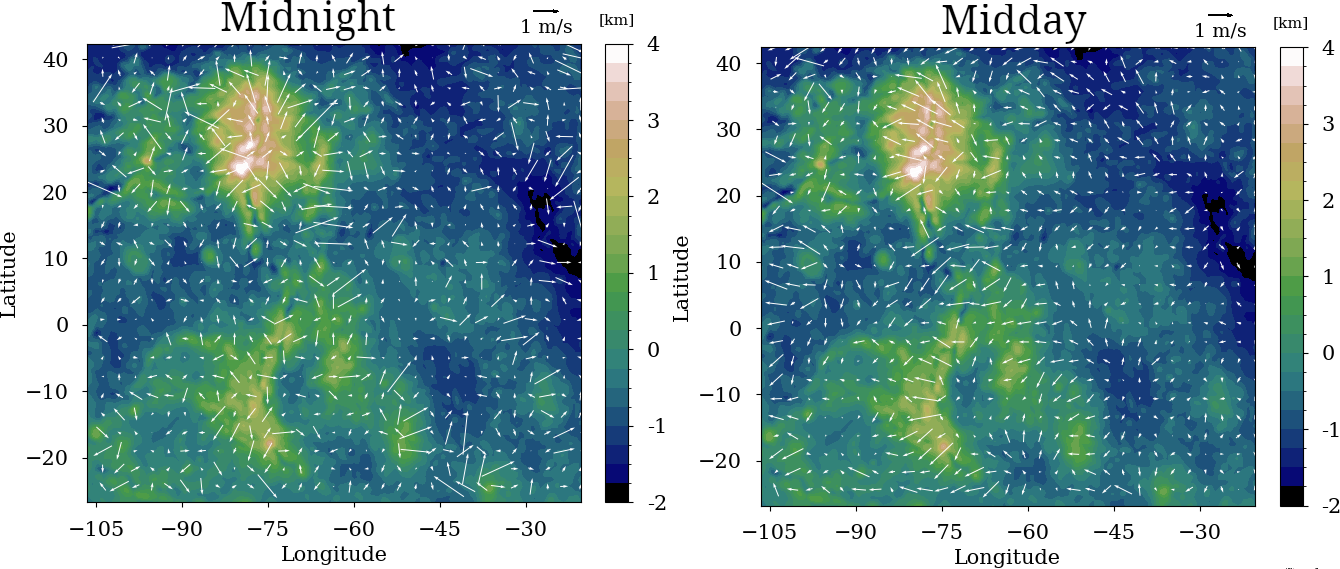Venus near-surface dynamics: slope winds and dust transport
- 1Sorbonne Université, LATMOS, Paris, France (maxence.lefevre@latmos.ipsl.fr)
- 2Sorbonne Université, LMD, Paris, France
1. Introduction
Below 10 km the dynamics of the Venus atmosphere is virtually unknown, only the VeGa-2 has successfully measured the temperature in that region. At the surface, only Venera-9 and 10 directly measured the wind for respectively 49 min and 90 s, and several other probes like Venera-13 and 14 measured indirectly the wind speed. The amplitude of the measured wind speed is inferior to 1 m/s [1] for the first 100 m.
The planetary boundary layer has been studied with a global circulation model (GCM) [2], exhibiting a strong effect of the solar heating on the amplitude of the slope wind in the tropics.
Two dune fields have been observed in radar measurements with Magellan [3], although the lack of knowledge about the spatial and temporal distribution of winds complicates the interpretation of sediment transport. The knowledge of the near-surface dynamics, winds and temperature cycles, is essential as the interaction between the surface and atmosphere is one of the objectives, with DAVINCI measuring temperature and winds at the surface [4], VERITAS and EnVision observing aeolian features [5]. In addition, several projects of long-duration lander at the surface of Venus, like the Seismic and Atmospheric Exploration of Venus (SAEVe) concept [6]. Characterization of the near-surface winds is also crucial to constrain lander trajectories/landing [7].
2. Model
To study the near-surface dynamics, the LMD Venus mesoscale model [8] is used, composed of the Weather-Research Forecast (WRF) non-hydrostatic dynamical core [9] coupled with the IPSL Venus GCM physics package [10]. Two domains were considered for this study, one centered on seven locations of VENERA landing sites, where winds were measured, and one centered on the North Pole where the largest mountain is located. The horizontal resolution is respectively 20 and 15 km. The mesoscale boundary conditions are forced with the IPSL Venus PCM.
3. Results
Fig 1 shows Snapshots map of horizontal winds 10m m above local surface (m/s) at noon (left) and midnight (right), exhibiting the diurnal cycle of surface wind. At night, there is the presence of katabatic winds, going down the slope, whereas at noon the winds are anabatic, going up the slope. This difference
cycle is due to the insolation of the surface. During the night, the potential temperature is significantly colder at the surface on the mountain slopes than at the same pressure level in the atmosphere away from the surface. This slope-induced baroclinicity drives the nighttime katabatic winds. During daytime, the reverse is true: the surface on the slopes is slightly warmer than the atmosphere at the same pressure level, inducing anabatic winds. There is also a strong variability of the amplitude of the wind. At noon, the wind over the first 100 m is below 1 m/s, consistent with the observations. At night however, the amplitude of the wind is larger. The amplitude of the wind is sufficient to engender saltation, especially at night. This diurnal cycle of the winds will have an impact on the surface temperature. In the flat low lands, the variation of the temperature will be around 4 K, whereas in the slope the temperature will vary only by less than 1 K. At high latitudes, the solar flux is much lower, and there is no diurnal cycle of the slope winds.

Figure 1: Snapshots map of horizontal winds 10 m above local surface (m/s) at noon (left) and midnight (right) in the center of the domain.
References
[1] Lorenz, R. D. Surface winds on Venus: Probability distribution from in-situ measurements. Icarus 264, 311–315 (2016).
[2] Lebonnois, S., Schubert, G., Forget, F. & Spiga, A. Planetary boundary layer and slope winds on Venus. Icarus 314, 149–158 (2018).
[3] Greeley, R. et al. Aeolian features on Venus - Preliminary Magellan results. Journal of Geophysical Research 97, 13 (1992).
[4] Garvin, J. B. et al. Revealing the Mysteries of Venus: The DAVINCI Mission. The Planetary Science Journal 3, 117 (2022).
[5] Ghail, R. C. et al. VenSAR on EnVision: Taking earth observation radar to Venus. International Journal of Applied Earth Observation and Geoinformation 64, 365–376 (2018).
[6] Kremic, T. et al. Long-duration Venus lander for seismic and atmospheric science. Planetary and Space Science 190, 104961 (2020).
[7] Knicely, J. J. C., Gilmore, M. S., Lynch, R. J. & Herrick, R. R. Strategies for safely landing on Venusian tesserae. Planetary and Space Science 228, 105652 (2023).
[8] Lefèvre, M., Spiga, A. & Lebonnois, S. Mesoscale modeling of Venus’ bow-shape waves. Icarus 335, 113376 (2020).
[9] Skamarock, W. C. & Klemp, J. B. A time-split nonhydrostatic atmospheric model for weather research and forecasting applications. Journal of Computational Physics 227, 3465–3485 (2008).
[10] Garate-Lopez, I. & Lebonnois, S. Latitudinal variation of clouds’ structure responsible for Venus’ cold collar. Icarus 314, 1–11 (2018).
How to cite: Lefevre, M., Lebonnois, S., spiga, A., and Forget, F.: Venus near-surface dynamics: slope winds and dust transport, Europlanet Science Congress 2024, Berlin, Germany, 8–13 Sep 2024, EPSC2024-384, https://doi.org/10.5194/epsc2024-384, 2024.